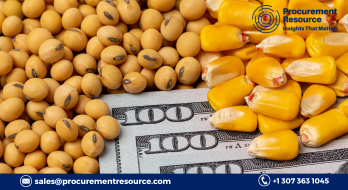Soybean Prices in Asia have been trending downward in 2024

The 2024 APAC soybean market reveals a strong dependency on Brazilian imports, with Brazil supplying 84% of China’s soybeans in August alone, amounting to 70.4 million metric tons by that month. Brazil’s role is pivotal, as it provides a stable supply despite early-year floods, which had negligible impact due to a timely harvest. Therefore, Brazil has been positing central in meeting China’s vast demand and maintaining soybean availability in APAC.
Soybean prices in China trended downward from early 2023 until mid-2024, with a brief rebound in August triggered by an anti-dumping probe against Canadian canola. This probe redirected demand back to soybeans, illustrating China's response to trade pressures and its ability to manage domestic prices amid shifting international trade dynamics. Here, China tactically navigated trade issues to stabilize its market under the influence of geopolitical factors on soybean pricing.
Domestically, China held 29 soybean auctions via Sinograin as of October 2024 to regulate its market. These auctions, along with high crushing activities in Q2 and Q3, allowed China to maintain a stable domestic supply, balancing imports and internal reserves effectively. The auction strategy highlights China's proactive measures in securing its soy needs while mitigating the impact of international price volatility.
Read More About Soybean Production Cost Reports - Get Free Sample Copy in PDF
In the broader APAC region, Northeast Asia, predominantly China, remains the primary consumer of feed grains, including corn, soybeans, and soymeal. However, there is a gradual shift in feed demand toward Southeast Asia, driven by the expansion of livestock industries. This shift points to evolving consumption trends, where Southeast Asia’s growing livestock sector starts shaping the regional feed demand, diversifying APAC's soybean market base.
The futures market on the Dalian Commodity Exchange reflects this complexity, with soybean oil prices firming up due to competition with palm oil. Chinese crushers are pre-selling soymeal for 2025 at a negative premium, a move that helps them hedge against price fluctuations and maintain profitability.
Analysts at Procurement Resource say that the 2024 APAC soybean market has been heavily reliant on Brazilian imports, with Brazil providing 84% of China’s supply by August, totaling 70.4 million metric tons. Despite early floods, Brazil’s timely harvest ensured a stable supply. Soybean prices in China dropped through mid-2024 but rebounded in August following an anti-dumping probe on Canadian canola, showing China’s strategic response to trade pressures. Domestically, China used 29 auctions to regulate its market and maintain supply, aided by strong crushing activities. While Northeast Asia leads feed grain consumption, Southeast Asia’s growing livestock industry is boosting regional demand. Soybean oil prices in the Dalian Commodity Exchange have firmed up, with Chinese crushers pre-selling soymeal to manage risks and stay competitive amid palm oil challenges.




